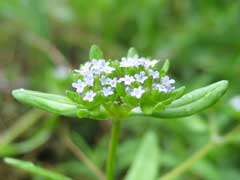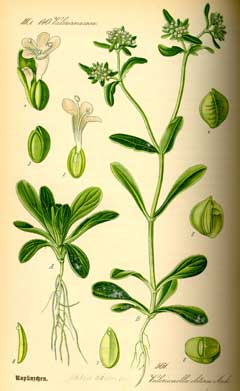 |
|
commons.wikimedia.org/wiki/User:Fabelfroh |
 |
| commons.wikimedia.org/wiki/File:Illustration_Valerianella_locusta0.jpg |
Translate this page:
Summary
Physical Characteristics

 Valerianella locusta is a ANNUAL growing to 0.3 m (1ft).
Valerianella locusta is a ANNUAL growing to 0.3 m (1ft).
See above for USDA hardiness. It is hardy to UK zone 5 and is not frost tender. It is in flower from April to June, and the seeds ripen from May to July. The species is hermaphrodite (has both male and female organs). The plant is self-fertile.
Suitable for: light (sandy), medium (loamy) and heavy (clay) soils. Suitable pH: mildly acid, neutral and basic (mildly alkaline) soils. It cannot grow in the shade. It prefers dry or moist soil.
UK Hardiness Map
US Hardiness Map
Synonyms
V. olitoria.
Plant Habitats
Hedgerow; Cultivated Beds;
Edible Uses
Edible Parts: Flowers Leaves
Edible Uses:
Young leaves - raw[1, 2, 4, 5, 12, 27, 33, 37]. A very mild flavour, with a delicate quality that makes them seem to melt in the mouth, they can be added in quantity to salads[183]. The leaves can be available all year round from successional sowings and will only require protection in the colder winters[K]. Flowers and flowering stems - raw[183].
References More on Edible Uses
Medicinal Uses
Plants For A Future can not take any responsibility for any adverse effects from the use of plants. Always seek advice from a professional before using a plant medicinally.
None known
References More on Medicinal Uses
The Bookshop: Edible Plant Books
Our Latest books on Perennial Plants For Food Forests and Permaculture Gardens in paperback or digital formats.

Edible Tropical Plants
Food Forest Plants for Hotter Conditions: 250+ Plants For Tropical Food Forests & Permaculture Gardens.
More

Edible Temperate Plants
Plants for Your Food Forest: 500 Plants for Temperate Food Forests & Permaculture Gardens.
More

More Books
PFAF have eight books available in paperback and digital formats. Browse the shop for more information.
Shop Now
Other Uses
References More on Other Uses
Cultivation details
A very easily grown plant, it prefers a fairly rich light soil[1, 37] though it tolerates most soils and wet or dry conditions[52]. Prefers a sunny position but tolerates some shade in summer[K]. This shade, plus an adequate supply of water, will slow down the plant's tendency to run to seed[200]. Late sowings will benefit from a sheltered sunny position and perhaps some protection in the winter. Often cultivated on a garden scale for its edible young leaves which, by successional sowing, can be available for most of the year although they will require protection in severe winters. There are several named varieties[183]. The plants do tend to run quickly to seed in the summer though. If allowed to flower, plants will often maintain themselves by self-sowing[K].
References Carbon Farming Information and Carbon Sequestration Information
Temperature Converter
Type a value in the Celsius field to convert the value to Fahrenheit:
Fahrenheit:
The PFAF Bookshop
Plants For A Future have a number of books available in paperback and digital form. Book titles include Edible Plants, Edible Perennials, Edible Trees,Edible Shrubs, Woodland Gardening, and Temperate Food Forest Plants. Our new book is Food Forest Plants For Hotter Conditions (Tropical and Sub-Tropical).
Shop Now
Plant Propagation
Seed - in order to obtain a continuous supply of salad leaves, it is best to sow the seed successionally from early spring to late summer in situ. A late summer sowing might also succeed, and this would supply edible leaves in the winter.
Other Names
If available other names are mentioned here
Native Range
TEMPERATE ASIA: Syria, Turkey, Russian Federation-Ciscaucasia (Ciscaucasia), Azerbaijan, Georgia, Russian Federation (Dagestan) EUROPE: Denmark, Finland, United Kingdom, Ireland, Norway, Sweden, Czechoslovakia, Austria, Belgium, Switzerland, Germany, Hungary, Netherlands, Poland, Russian Federation-European part (European part (south)), Belarus, Moldova, Ukraine (incl. Krym), Former Yugoslavia, Albania, Bulgaria, Greece, Italy (incl. Sardinia, Sicily), Romania, Spain, France (incl. Corsica), Portugal AFRICA: Spain (Canarias), Portugal (Madeira Islands), Algeria, Morocco
Weed Potential
Right plant wrong place. We are currently updating this section.
Please note that a plant may be invasive in one area but may not in your area so it's worth checking.
Conservation Status
IUCN Red List of Threatened Plants Status :

Growth: S = slow M = medium F = fast. Soil: L = light (sandy) M = medium H = heavy (clay). pH: A = acid N = neutral B = basic (alkaline). Shade: F = full shade S = semi-shade N = no shade. Moisture: D = dry M = Moist We = wet Wa = water.
Now available:
Food Forest Plants for Mediterranean Conditions
350+ Perennial Plants For Mediterranean and Drier Food Forests and Permaculture Gardens.
[Paperback and eBook]
This is the third in Plants For A Future's series of plant guides for food forests tailored to
specific climate zones. Following volumes on temperate and tropical ecosystems, this book focuses
on species suited to Mediterranean conditions—regions with hot, dry summers and cool, wet winters,
often facing the added challenge of climate change.
Read More
Expert comment
Author
(L.)Laterr.
Botanical References
17200
Links / References
For a list of references used on this page please go here
Readers comment